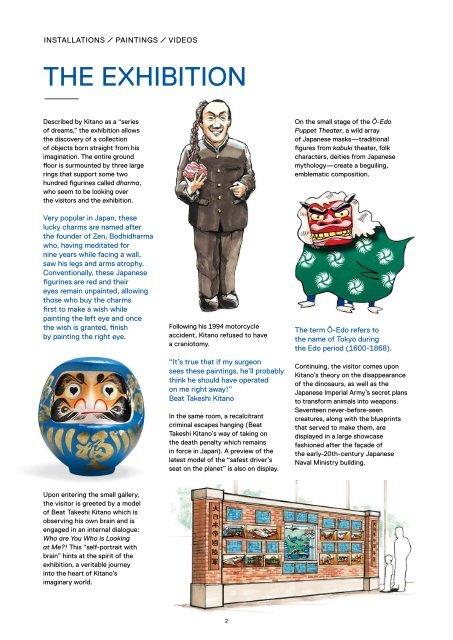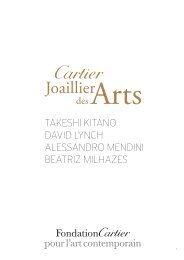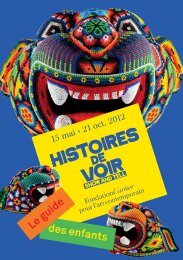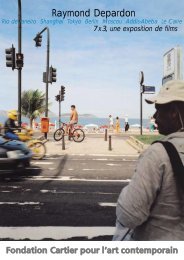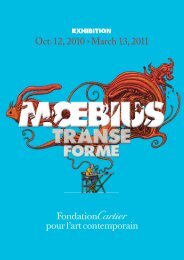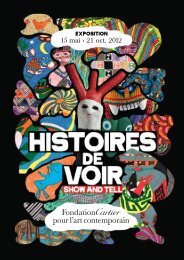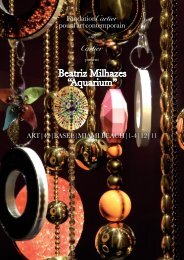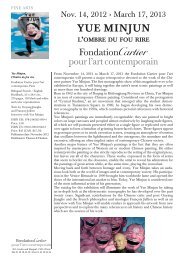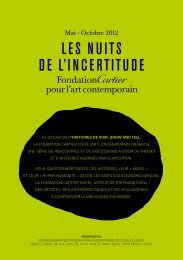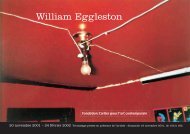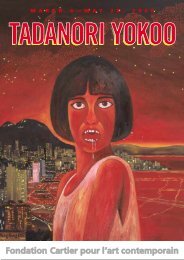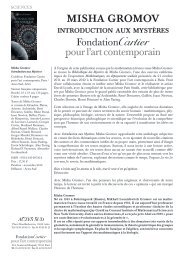March 11 ? Sept. 12, 2010 - Fondation Cartier pour l'art ...
March 11 ? Sept. 12, 2010 - Fondation Cartier pour l'art ...
March 11 ? Sept. 12, 2010 - Fondation Cartier pour l'art ...
Create successful ePaper yourself
Turn your PDF publications into a flip-book with our unique Google optimized e-Paper software.
INSTAllATIONS / PAINTINGS / VIDEOS<br />
THE EXHIBITION<br />
—<br />
Described by Kitano as a “series<br />
of dreams,” the exhibition allows<br />
the discovery of a collection<br />
of objects born straight from his<br />
imagination. The entire ground<br />
floor is surmounted by three large<br />
rings that support some two<br />
hundred figurines called dharma,<br />
who seem to be looking over<br />
the visitors and the exhibition.<br />
Very popular in Japan, these<br />
lucky charms are named after<br />
the founder of Zen, Bodhidharma<br />
who, having meditated for<br />
nine years while facing a wall,<br />
saw his legs and arms atrophy.<br />
Conventionally, these Japanese<br />
figurines are red and their<br />
eyes remain unpainted, allowing<br />
those who buy the charms<br />
first to make a wish while<br />
painting the left eye and once<br />
the wish is granted, finish<br />
by painting the right eye.<br />
upon entering the small gallery,<br />
the visitor is greeted by a model<br />
of Beat Takeshi Kitano which is<br />
observing his own brain and is<br />
engaged in an internal dialogue:<br />
Who are You Who is Looking<br />
at Me?! This “self-portrait with<br />
brain” hints at the spirit of the<br />
exhibition, a veritable journey<br />
into the heart of Kitano’s<br />
imaginary world.<br />
Following his 1994 motorcycle<br />
accident, Kitano refused to have<br />
a craniotomy.<br />
“It’s true that if my surgeon<br />
sees these paintings, he’ll probably<br />
think he should have operated<br />
on me right away!”<br />
Beat Takeshi Kitano<br />
In the same room, a recalcitrant<br />
criminal escapes hanging (Beat<br />
Takeshi Kitano’s way of taking on<br />
the death penalty which remains<br />
in force in Japan). A preview of the<br />
latest model of the “safest driver’s<br />
seat on the planet” is also on display.<br />
2<br />
On the small stage of the Ô-Edo<br />
Puppet Theater, a wild array<br />
of Japanese masks—traditional<br />
figures from kabuki theater, folk<br />
characters, deities from Japanese<br />
mythology—create a beguiling,<br />
emblematic composition.<br />
The term Ô-Edo refers to<br />
the name of Tokyo during<br />
the Edo period (1600-1868).<br />
Continuing, the visitor comes upon<br />
Kitano’s theory on the disappearance<br />
of the dinosaurs, as well as the<br />
Japanese Imperial Army’s secret plans<br />
to transform animals into weapons.<br />
Seventeen never-before-seen<br />
creatures, along with the blueprints<br />
that served to make them, are<br />
displayed in a large showcase<br />
fashioned after the façade of<br />
the early-20th-century Japanese<br />
Naval Ministry building.


